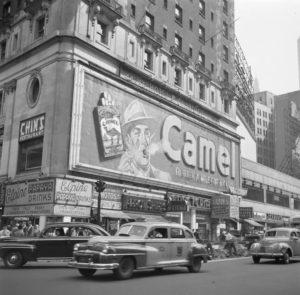For nearly a century, New York City has had a love-hate relationship with the signs of Times Square.

The famous “Camel Man” blowing smoke rings in Times Square
They’ve been alternately viewed as gaudy eyesores and a spectacular attraction, as a commercial blight and a wonder of the world. They earned Broadway its nickname “The Great White Way” and served as a stage set for corporate egos and the wizardry of electrical technicians.
When Japanese companies wanted to demonstrate their ascendance in the 1980s, they rented the biggest signs in Times Square and put the names “Panasonic” and “Mitsubishi” in shimmering, computer-controlled LED lights where “Wrigley’s Gum” and “Chevrolet” had once reigned supreme.
When plans for Times Square’s renovation took shape in the mid-Eighties, the lights became a focal point of debate. Preservationists and aesthetes – the same forces that in the early days had opposed the signs – waxed nostalgic. The signs were saved and provisions were made to set aside space for new ones on new buildings.
Had this not been the case, the signs would be history today, and the current exhibit at the New-York Historical Society – “Signs and Wonders: the Spectacular Lights of Times Square” – would have a funereal air about it. As is, the show is exuberant, confidently strutting its stuff through the decades, from the 50-foot Heinz pickle of 1898 to the steaming “Cup o’ Noodles” of today. The story is told mostly through archival photographs, with a few colorful mock-ups to give a sense of the real signs and so visitors can compare the different effects of neon, argon, incandescent, fluorescent, and LED (light-emitting diode) displays.
The show begins with the early 1900s, when Times Square (named for the newspaper and defined as the bow-tie shaped area between 42nd and 48th streets with Seventh Avenue and Broadway crossing at the knot) had begun to display billboard advertisements for the theaters and other neighborhood attractions. The signs became larger until they covered whole sides of buildings.
Things took off with the invention of the electric sign. The father of the “Great White Way” was O.J. Gude, an electrical engineer who, for many years, built almost all the spectacular signs in the Broadway area. His masterpiece was probably the block-long Wrigley’s sign on the Putnam building, between 43rd and 44th streets. It had flowing fountains, peacocks with 60-foot-long tails, floral motifs, and six 15-foot-high spearmen – symbol of the spearmint flavor.
In 1910, Ohio businessman Elwood Rice came to New York City with a plan to make the world’s biggest electric sign. Atop the Normandie Hotel he erected one that was 72 feet high and 90 feet wide and displayed a static chariot-racing scene from “Ben Hur,” a popular play of the time. He called it “Leaders of the World” and solicited paid messages from world leaders for the moving part of the sign. Few took him up on it, however, and after running service announcements for a time, Rice declared the sign a success and went back to Ohio.
The trick of putting animation in signs was discovered in the early 1900s. Bulbs were arranged in several overlapping images and lit in rapid sequence to create the illusion of movement. The best was the Corticelli Kitten at 42nd and Broadway. It leaped, twisted, and somersaulted as it played with a spool of thread, an image that conveyed the message that Corticelli silk thread did not tangle.
As signs became more extravagant, the backlash began. Designers and urban planners, troubled by the scale and garishness of the signs, tried to restrict them. In 1909, the Municipal Art Society succeeded in passing a law that restricted the size and location of signs, but it was abolished because the restrictions were based solely on aesthetics.
From 1930 to 1934, the glamorous Pepsodent girl – her outline based on a popular Ziegfield star – swung beneath a clock at the north end of Times Square. With every swing the clock lit up and lights flashed, a sequence that occurred with dizzying regularity every 10 seconds.
Neon was introduced in 1910 and proved a wonderfully versatile medium for spectacular signs because of its flexibility and vivid colors. But restrictive patents limited its use, and it wasn’t until 1936 that the city saw its first spectacular neon sign: Wrigley’s enormous underwater scene with tropical fish – some 42 feet long – swimming around a pack of gum.
It wasn’t very high tech, but steam – introduced in 1933 – has remained a wonderful special effect. For years, steam rose from a gigantic A&P coffee mug. Then there was the famous Camel man, who blew gigantic smoke rings over the square and donned a soldier’s uniform in 1942. Today, the steam rises from Cup o’ Noodles.
After World War II, the sign designer Artkraft Strauss dominated the Times Square spectaculars. It created the 1952 Canadian Club sign with its prismatic script letters suspended a foot in front of a gold neon background. The 1980s brought the introduction of computer-generated LED signs. Also on view are working models of the news “zipper” that lit up the headlines at One Times Square; the illuminated “T” of the Suntory whiskey ad of the 1980s; the new fiber-optic AT&T globe on the Marriott Marquis; and the current Coca-Colaad with the bottle that fills and drains itself.
But the best display, of course, is Times Square itself, where tourists can still look up and know by the razzle-dazzle that they’ve arrived in the Big Apple. Other places – Las Vegas, Tokyo – may have surpassed Times Square in sheer extravagance, but New York has the tradition.
The New-York Historical Society
1998

